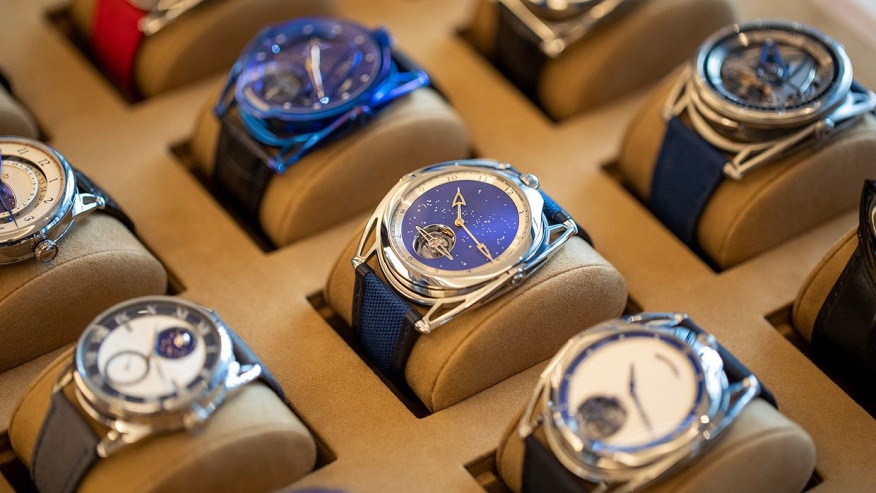Purchasing a luxury watch can be extremely intimidating because there are so many options, and some models are expensive. For instance, a collector must evaluate their needs and requirements from the timepiece and how it appreciates over time. On the other hand, ordinary watch buyers must consider their aesthetic preferences and whether the luxury watch suits their style. You must evaluate your options carefully because the strap and face of the watch can significantly alter how and where you wear your watch. But worry not because we will look at the critical features of luxury watches below.
Precious metals
The precursor materials utilized to create a watch determine the characteristics of the finished item. A high-end luxury watch uses precious metals like gold or platinum to give the timepiece a distinctive appearance and maintain its originality throughout time. Additionally, precious metals have some characteristics that make them perfect for watchmaking.
Regular steel can irritate the skin and trigger allergies when exposed to sweat and moisture, while gold or platinum are kind to the skin and don’t react to environmental changes. However, using precious metals increases the cost of constructing a watch, increasing the price of the finished item marginally.
Some high-end watches employ stainless steel with a PVD coating to help protect the watch’s color and lower the likelihood of irritation. These watches certainly cost less in comparison.
Mechanical movement
One of the fundamental characteristics of luxury timepieces is the mechanical watch mechanism. The most costly timepieces in the world have mechanical movements because they are delicate and require a watchmaker’s ability and knowledge. The combination of numerous complex watch parts yields these mechanical movements. The smooth operation of a watch’s little pieces keeps it operating.
Most high-end watches have automatic mechanical movements, which means the watch mechanism is intelligent enough to recharge itself using the wearer’s movement as an energy source. Such watches do not require manual winding except in cases where the watch has been idle for a long time.
Quartz watches are simple timepieces that don’t need as much complexity in their construction or upkeep. They lack the workmanship of mechanical watches and don’t fall under the luxury watch category.
People spend thousands of dollars on high-end timepieces with mechanical mechanisms, symbols of the horologists’ artistic skill. If you’re a watch fanatic, ensure you spend a fortune on a mechanical masterpiece that took months of meticulous work and dedication to construct and is built to last for generations.
A reputable brand name
Being brand mindful when purchasing luxury watches is not snobbery; instead, it is wise. Some watch companies have built up their brand equity over many years. They excel at what they do, which results in a happy elitist clientele. The best and most costly watch brands in the world are Swiss.
These companies have been producing timepieces for famous people for many years, and they have long stood for wealth, position, and class. Their products are evaluated against necessary criteria and, most importantly, have received positive client feedback. Top-tier luxury watch companies with a history include Patek Phillippe, Rolex, Breitling, Tag Heuer, Omega, Rado, etc.
Exclusiveness and originality
Exclusiveness is a crucial component of high-end timepieces. The most expensive luxury timepieces are not mass-produced and do not target a broad consumer base. Not everyone can afford luxury watches because they are so pricey—those who do pay a premium for exclusivity.
Limited edition, elitist consumers are the target market for ultra-high-end luxury timepieces. Some unique models are made in limited quantities and are extremely rare, but these limited editions excite wealthy watch enthusiasts.
Required certification
Leading brands of high-end luxury timepieces come with certification against specific standards to ensure the product lives up to the manufacturer’s claims. These accreditations represent yet another standard for premium watches.
A well-known watch rating system called “chronometer rating” denotes high-quality production in terms of luxury watch design, production, components, assembly, and precision against predetermined criteria. It is of relatively high quality, and to comply with the requirements of the chronometer, special procedures are taken at every stage of manufacture. Chronometer-rated watches are high-end, luxurious timepieces.
Other requirements exist for particular categories of high-end timepieces. For instance, high-end diving watches are tested per the ISO 6425 standard, which determines whether a watch is suitable for use underwater and verifies that it possesses key components typical of diving equipment. Such requirements and approvals promote a brand’s dependability and trustworthiness.
The watch glass
The watch glass, also known as the watch crystal, protects the watch’s delicate internal mechanisms from external impurities like water, dirt, and other particles. Although the watch crystal may appear to be a relatively straightforward part at first appearance, it is constructed with the same attention as the rest of the watch.
Most of the top luxury timepieces on the market are built with sapphire crystal, while some luxury brands also employ mineral glass or plexiglass. Because sapphire crystal is uncommon, most high-end watches utilize a synthetic substitute made in special labs.
The manufacturing method calls for specially made cutters topped with diamonds, one of the few materials tougher than sapphire crystal. This crystal has the same structure as its natural counterpart and is designed to be extremely hard and durable. As a result, the watch has the best possible scratch and break resistance, offering the inner workings superb protection.
Don’t let excessive functionality fool you!
Luxury timepieces may or may not be highly technological devices. A watch’s level of luxury is unrelated to the variety of complexities it offers. Some costly dress watches, for instance, are basic, exquisite clocks that meet all requirements for quality and craftsmanship but only provide the ability to tell the time. Conversely, some cheap, average-quality watches can do various functions and vice versa. The world’s top watch brands each choose their complications, and a wide range exists among them. With rare exceptions, Rolex watches are more frequently simple than Patek Phillippe pieces, which often feature innovative complications. However, horologists give both brands excellent ratings.



